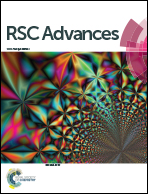Recognition and selective adsorption of pesticides by superparamagnetic molecularly imprinted polymer nanospheres
Abstract
Magnetic molecularly imprinted polymers (MMIPs) were synthesized by cross-linking methyl methacrylate (MMA) and maleic anhydride (MA) copolymer, poly(MMA-co-MA), with triethylenetetramine (TETA) which has been used for the selective adsorption of pesticides phosalone, diazinon, and chlorpyrifos from aqueous solutions. To introduce superparamagnetic properties, amino-functionalized magnetic Fe3O4 nanoparticles (Fe3O4-NH2) were prepared by a simple one-pot method. The MMIPs were characterized by FT-IR, XRD, VSM, TGA, TEM and SEM methods. After templates removal, the selectivity of the MMIPs was verified by direct adsorption of a single reference pesticide and mixed pesticides. The MMIPs indicated excellent recognition and binding affinity toward the tested pesticides, and the maximum adsorption capacity for phosalone, diazinon, and chlorpyrifos by Langmuir equation was 196.07, 192.30 and 172.41 mg g−1, respectively. After four adsorption–desorption cycles, the MMIP maintained its adsorption capacity without significant loss. The prepared MMIPs possess the enhanced capacity and selectivity of the tested pesticides and have the value of practical applications.


 Please wait while we load your content...
Please wait while we load your content...